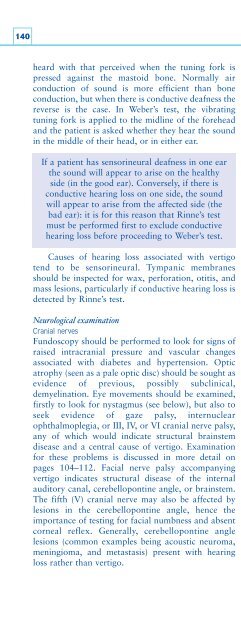Create successful ePaper yourself
Turn your PDF publications into a flip-book with our unique Google optimized e-Paper software.
140heard with that perceived when the tuning fork ispressed against the mastoid bone. Normally airconduction of sound is more efficient than boneconduction, but when there is conductive deafness thereverse is the case. In Weber’s test, the vibratingtuning fork is applied to the midline of the foreheadand the patient is asked whether they hear the soundin the middle of their head, or in either ear.If a patient has sensorineural deafness in one earthe sound will appear to arise on the healthyside (in the good ear). Conversely, if there isconductive hearing loss on one side, the soundwill appear to arise from the affected side (thebad ear): it is for this reason that Rinne’s testmust be performed first to exclude conductivehearing loss before proceeding to Weber’s test.Causes of hearing loss associated with vertigotend to be sensorineural. Tympanic membranesshould be inspected for wax, perforation, otitis, andmass lesions, particularly if conductive hearing loss isdetected by Rinne’s test.Neurological examinationCranial nervesFundoscopy should be performed to look for signs ofraised intracranial pressure and vascular changesassociated with diabetes and hypertension. Opticatrophy (seen as a pale optic disc) should be sought asevidence of previous, possibly subclinical,demyelination. Eye movements should be examined,firstly to look for nystagmus (see below), but also toseek evidence of gaze palsy, internuclearophthalmoplegia, or III, IV, or VI cranial nerve palsy,any of which would indicate structural brainstemdisease and a central cause of vertigo. Examinationfor these problems is discussed in more detail onpages 104–112. Facial nerve palsy accompanyingvertigo indicates structural disease of the internalauditory canal, cerebellopontine angle, or brainstem.The fifth (V) cranial nerve may also be affected bylesions in the cerebellopontine angle, hence theimportance of testing for facial numbness and absentcorneal reflex. Generally, cerebellopontine anglelesions (common examples being acoustic neuroma,meningioma, and metastasis) present with hearingloss rather than vertigo.Motor system (see page 148)Testing for long tract motor signs (tone, power, andreflexes) is important to document any subclinicaldisease affecting the pyramidal tracts. This localizesthe cause of vertigo or imbalance in the brainstem(for example in brainstem stroke or Arnold–Chiarimalformation), or indicates pyramidal pathologyelsewhere in the nervous system, which can occur indemyelination.Cerebellar system (see page 176)Cerebellar disease causes unsteadiness and ataxia,rather than the sensations of dizziness or vertigo, butbecause of the close interrelationship between thecerebellar and vestibular systems both functionallyand neuroanatomically, it is mandatory to test forupper limb cerebellar signs (finger-nose-finger testand rapid alternating movements [dysdiadochokinesis])and lower limb cerebellar signs (heel-shintest) in all dizzy and vertiginous patients.Abnormalities indicate disease of the cerebellum or itsconnections, and tend to occur ipsilateral to anycerebellar lesion.Sensory system (see page 214)Proprioception (joint and position sense), mediatedby large fibre peripheral nerves and the posteriorcolumns of the spinal cord, is fundamental tomaintaining equilibrium. If reduced it will causeimbalance and unsteadiness; this may be initiallyapparent only in the dark because vision compensatesfor any deficiency. Minor reductions inproprioception, common as people age, mayexacerbate dizziness from other causes.Nystagmus assessmentNystagmus is an involuntary oscillation of the eyes.Nystagmus may be pendular (equal velocity andamplitude in both directions of movement[sinusoidal]) or jerk (slow phase drift in one direction,then a corrective quick phase in the other). The fastphase of jerk nystagmus is used to define the directionof the nystagmus, though the pathological movementis the slow one. Nystagmus usually involves a to-andfrooscillating movement of the eyes, but there may betorsional or rotatory components. Torsionalmovements (around the viewing axis of the eye) areseen with both end-organ and brainstem vestibular
















